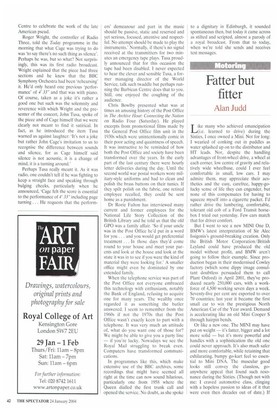Fatter but fitter
Alan Judd
T ike many who achieved emancipation
learned to drive) during the Sixties, I once owned a Mini. Not for long: I wearied of conking out in puddles as water splashed up on to the distributor and HT leads. Nor, despite the handling advantages of front-wheel drive, a wheel at each corner, low centre of gravity and relatively wide wheelbase, could I ever feel comfortable in small, low cars. I may admire them, may appreciate their aesthetics and the easy, carefree, happy-golucky sense of life they can engender, but none of this compensates for having to squeeze myself into a cigarette packet. I'd rather drive the lumbering, comfortable, tolerant old cob of a Ford Transit horsebox I tried out yesterday. Few cars match that for driver comfort.
But I went to see a new MINI One D, BMW's latest interpretation of Sir Alec Issigonis's ground-breaking creation. Only the British Motor Corporation/British Leyland could have produced the old model without profit, and BMW aren't going to follow their example. Since production began in their modernised Cowley factory (which some dippy image consultant doubtless persuaded them to call Plant Oxford) in April 2001, they've produced nearly 250,000 cars, with a workforce of 4,500 working seven days a week. Seventy-five per cent are exported to over 70 countries; last year it became the first small car to win the prestigious North American Car of the Year award. Demand is accelerating like an old Mini Cooper S through hairpin bends.
Or like a new one. The MINI may have put on weight — it's fatter, bigger and a lot more solid — but it's more powerful and handles with a sophistication the old one could never approach. It's also much safer and more comfortable, while retaining that exhilarating, bumpy go-kart feel so essential to Mini DNA. The muscular good looks still convey the classless, goanywhere appeal that found such resonance during the Sixties. (Though not with me: I craved automotive class, clinging with a hopeless passion to ideas of it that were even then decades out of date.) If you liked the old Mini, you should like this one. You should prefer it.
I tested the latest version, the first diesel-engined Mini or MINI. When the Mini came out, diesel was a dirty word, fit for ships, railway engines, lorries and tractors but rare (in Britain) in cars. You were most likely to find it in a minority of LandRovers and in London cabs; both struggled to pull the skin off a rice pudding. Now diesel engines power about 30 per cent of new cars, unrecognisably more efficient, powerful, clean and quiet than their predecessors. And of few is this more true than the outstanding 1.4 litre, direct-injection, second-generation common rail unit that BMW have put in this MINI.
It's an adaptation of the Toyota Yaris diesel engine, a robust and willing gem of a power unit, yielding torque of 180Nm at 2000 rpm and power of 75 bhp at 4000 rpm, The cam is chain-driven rather than beltdriven (more durable, less maintenance), top speed is 103 mph, 0-62mph takes 13.8 seconds, and you should be able to do the 600-odd miles from the Isle of Skye to the Isle of Wight on one 11-gallon tank. Standard consumption tests give the urban cycle as 48.7mpg, extra urban 65.7mpg, combined 58.9 mpg. Service intervals are 15,000 miles (although, as with any car with long service intervals, it would be sensible to change the oil between services after about 60,000 miles).
Combined with the enjoyably precise short-throw six-speed gearbox and suspension and chassis based on the BMW 3 series, this engine gives a drive both punchy and tolerant. You do need to drive it — use those gears, don't just amble along in some gear or other — but you can also cruise without labouring at 40 mph on the level in 6th and still accelerate easily to 70 mph. The engine is quiet, at 70 mph almost inaudible beneath the wind noise (presumably an unintended reminder of the old Mini). Unlike that one, however, this goes up hills. You can even tow with it (up to over half a tonne).
The interior is available with dozens of options but overall it is ruthless modernist rather than sentimental retro, though they've kept the big central dial of the old Mini and a superior array of metal switches. The seats (leather in the test car) are good in front, with plenty of lumbar support, but only OK in the back, where you're short on headand leg-room. The boot is tiny but the rear seatbacks fold down, so golf and shopping are possible. Steering is positive and direct, there are airbags everywhere and the brakes are excellent, with the possibly life-saving Cornering Brake Control system as standard. It costs £11,385 on the road, If I were buying a MINI, this is the one I'd go for. It's as fast as most of us want, is splendidly frugal and feels solid and comfortable without any loss of liveliness. And it would fit neatly into the back of that Transit horsebox.



























































 Previous page
Previous page